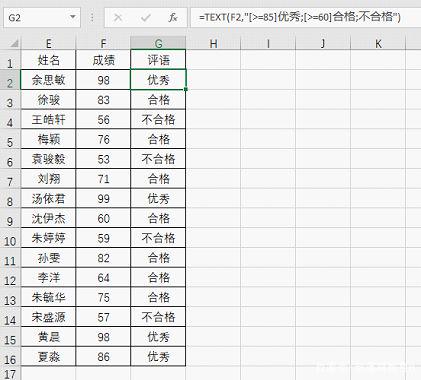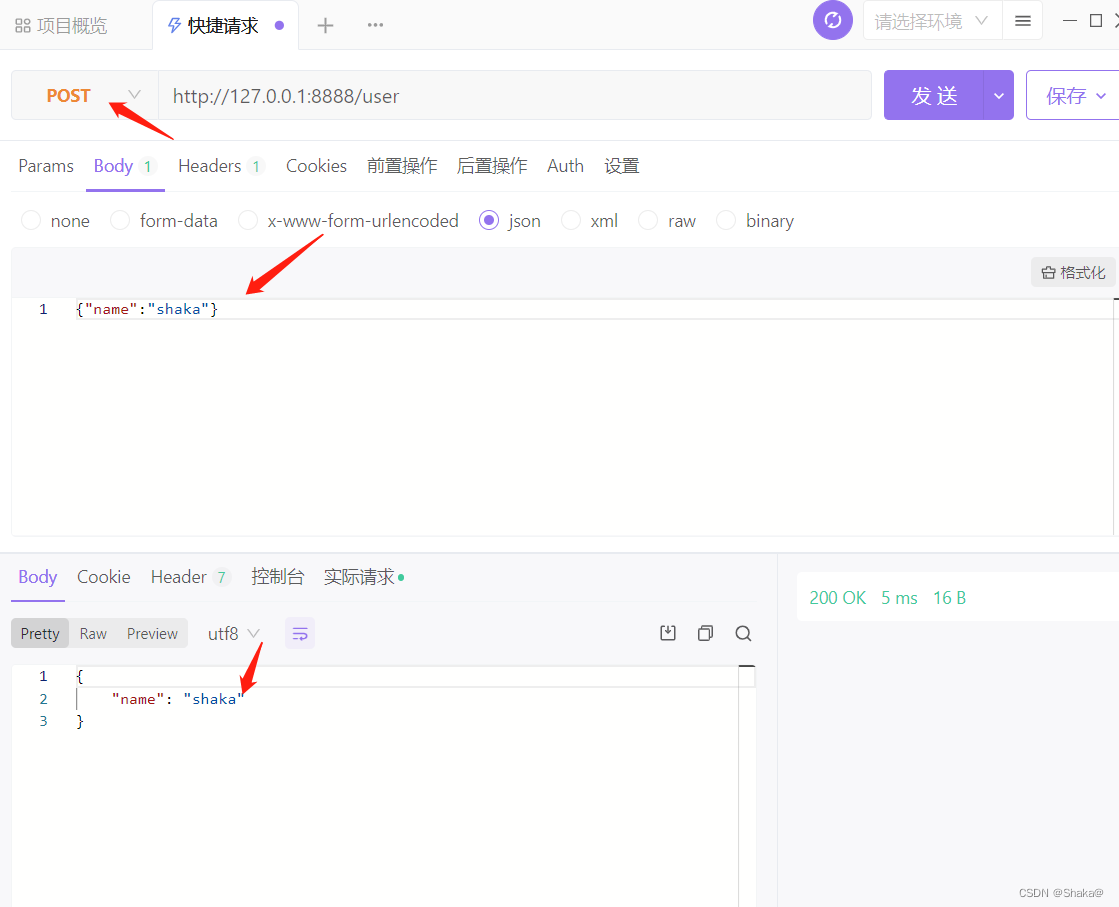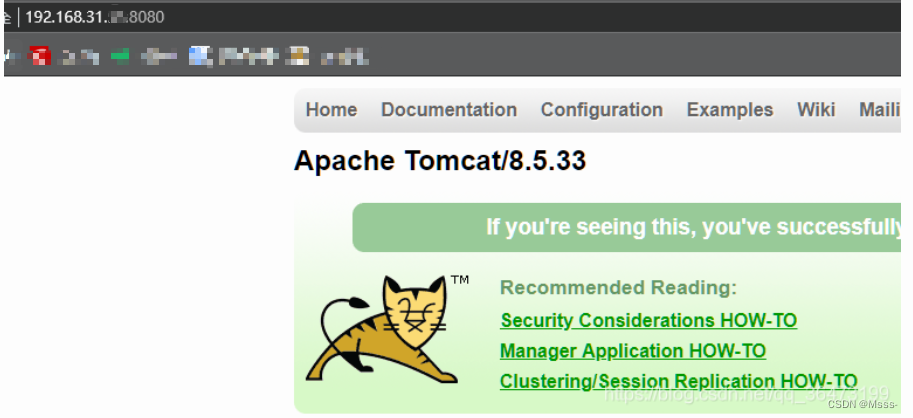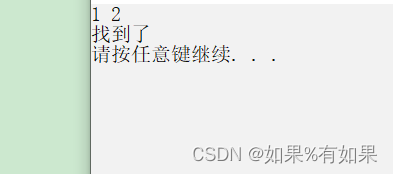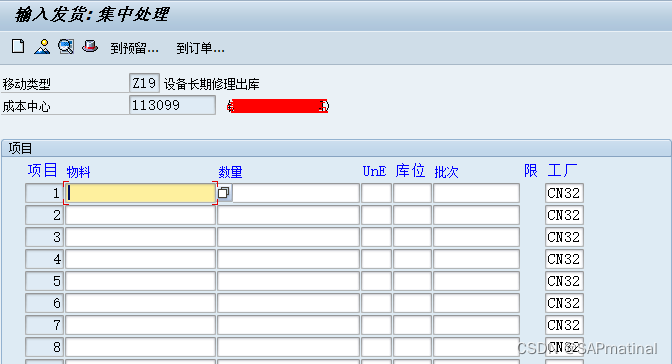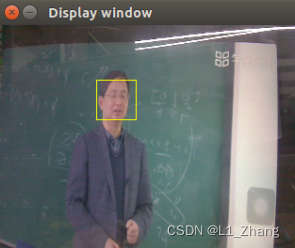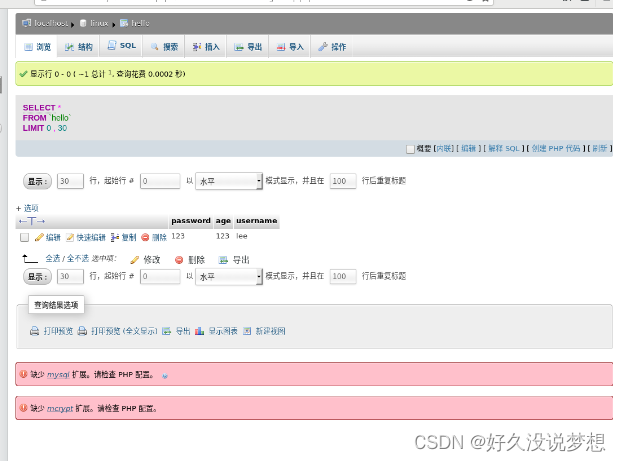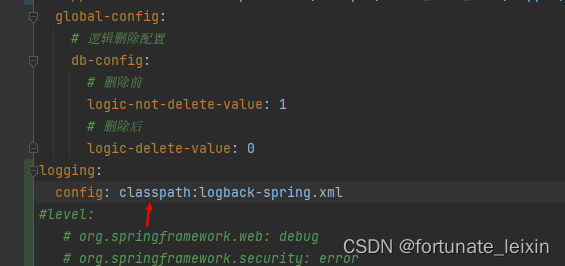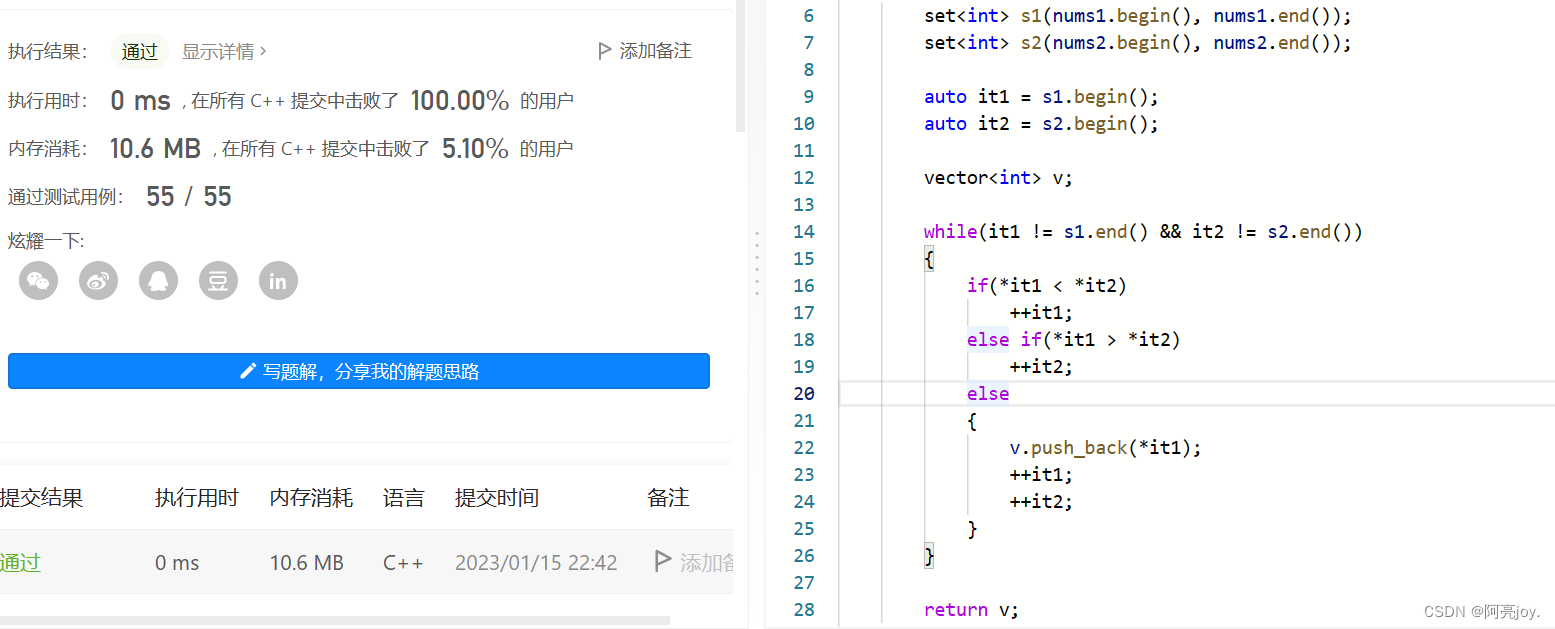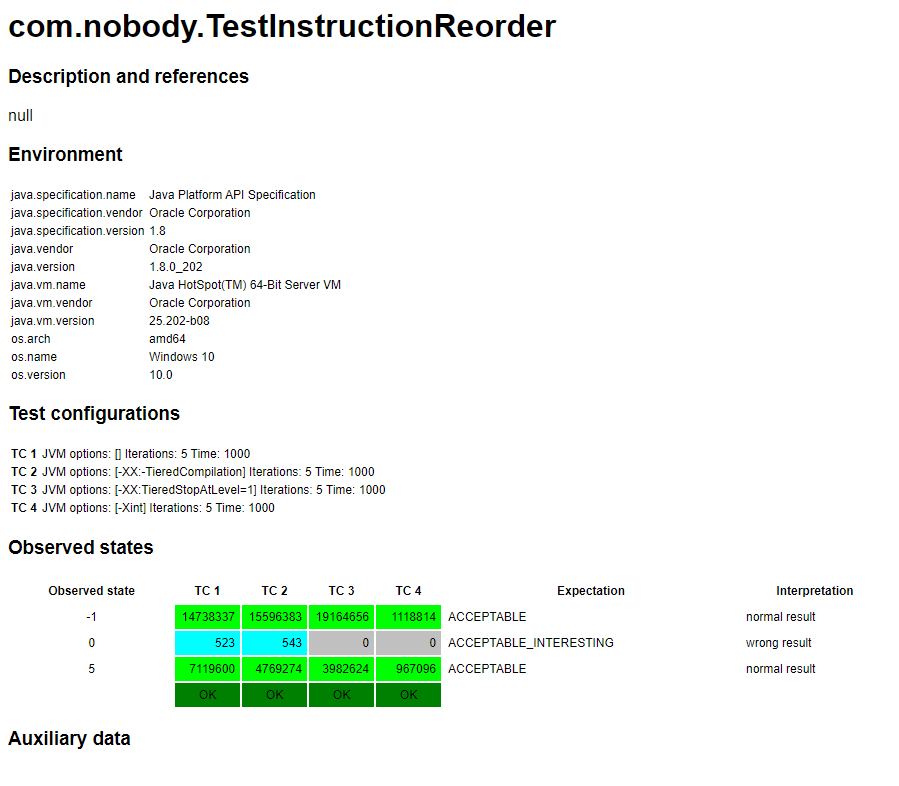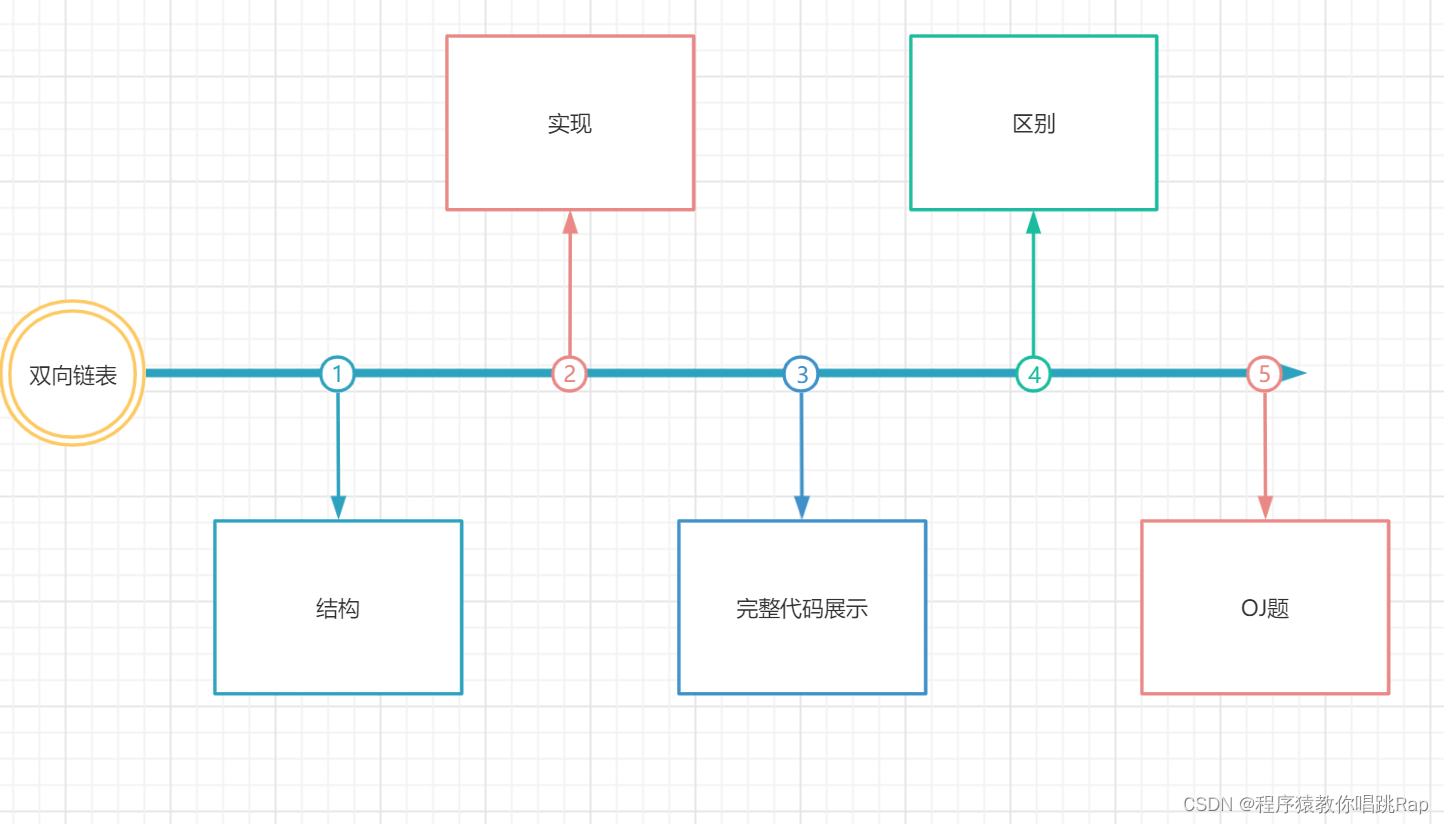
1.双向链表的结构

2.双向链表的实现
首先在VS里面的源文件建立test.c和List.c,在头文件里面建立List.h
List.h:
#pragma once
#include <stdio.h>
#include <stdlib.h>
#include <assert.h>
typedef int LTDateType;
typedef struct ListNode
{
LTDateType data;
struct ListNode* next;
struct ListNode* prev;
}LTNode;
2.1 初始化
List.h:
LTNode* ListInit(LTNode* phead);//初始化List.c:
#include "List.h"
LTNode* ListInit()
{
//哨兵位头结点
LTNode* phead = (LTNode*)malloc(sizeof(LTNode));
phead->next = phead;
phead->prev = phead;
return phead;
}test.c
#include "List.h"
void TestList1()
{
LTNode* plist = ListInit();
}
int main()
{
TestList1();
return 0;
}2.2 打印
List.h:
void ListPrint(LTNode* phead);//打印List.c:
void ListPrint(LTNode* phead)
{
assert(phead);
LTNode* cur = phead->next;
while (cur != phead)
{
printf("%d ", cur->data);
cur = cur->next;
}
printf("\n");
}2.3 申请结点
List.h:
LTNode* BuyListNode(LTDateType x);//申请结点 List.c:
LTNode* BuyListNode(LTDateType x)
{
LTNode* newnode = (LTNode*)malloc(sizeof(LTNode));
newnode->data = x;
newnode->next = NULL;
newnode->prev = NULL;
return newnode;
}2.4 尾插
List.h:
void ListPushBack(LTNode* phead, LTDateType x);//尾插 List.c:
void ListPushBack(LTNode* phead, LTDateType x)
{
assert(phead);
LTNode* tail = phead->prev;
LTNode* newnode = BuyListNode(x);
tail->next = newnode;
newnode->prev = tail;
phead->prev = newnode;
newnode->next = phead;
}test.c
#include "List.h"
void TestList1()
{
LTNode* plist = ListInit();
ListPushBack(plist, 1);
ListPushBack(plist, 2);
ListPushBack(plist, 3);
ListPrint(plist);
}
int main()
{
TestList1();
return 0;
}运行结果:

2.5 尾删
List.h:
void ListPopBack(LTNode* phead);//尾删List.c:
void ListPopBack(LTNode* phead)
{
assert(phead);
assert(phead->next != phead);//排除为空的情况
LTNode* tail = phead->prev;
phead->prev = tail->prev;
tail->prev->next = phead;
free(tail);
}test.c
#include "List.h"
void TestList1()
{
LTNode* plist = ListInit();
ListPushBack(plist, 1);
ListPushBack(plist, 2);
ListPushBack(plist, 3);
ListPrint(plist);
ListPopBack(plist);
ListPrint(plist);
}
int main()
{
TestList1();
return 0;
}运行结果:

2.6 头插
List.h:
void ListPushFront(LTNode* phead, LTDateType x);//头插List.c:
void ListPushFront(LTNode* phead, LTDateType x)
{
assert(phead);
LTNode* newnode = BuyListNode(x);
LTNode* next = phead->next;
phead->next = newnode;
newnode->prev = phead;
newnode->next = next;
next->prev = newnode;
}test.c
#include "List.h"
void TestList1()
{
LTNode* plist = ListInit();
ListPushBack(plist, 1);
ListPushBack(plist, 2);
ListPushBack(plist, 3);
ListPrint(plist);
ListPopBack(plist);
ListPrint(plist);
ListPushFront(plist, 10);
ListPrint(plist);
}
int main()
{
TestList1();
return 0;
}运行结果:
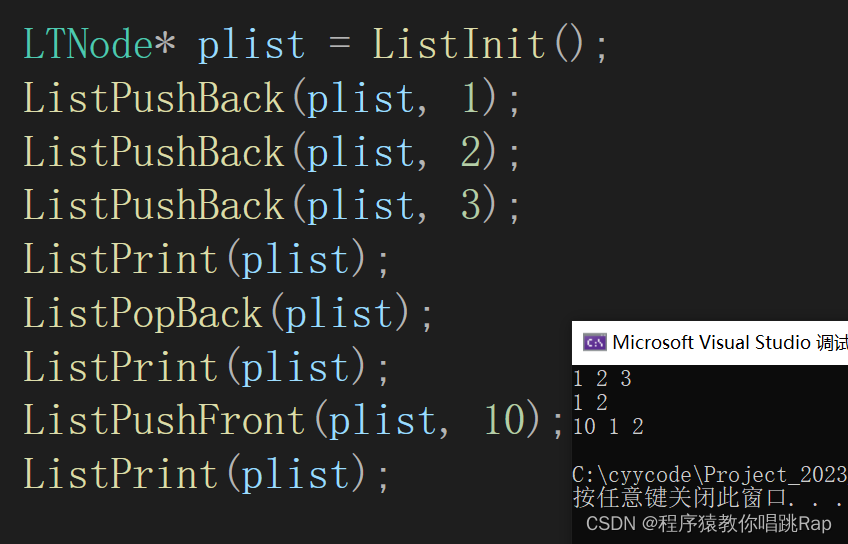
2.7 头删
List.h:
void ListPopFront(LTNode* phead);//头删List.c:
void ListPopFront(LTNode* phead)
{
assert(phead);
assert(phead->next != phead);
LTNode* next = phead->next;
LTNode* nextNext = next->next;
phead->next = nextNext;
nextNext->prev = phead;
free(next);
}test.c
#include "List.h"
void TestList1()
{
LTNode* plist = ListInit();
ListPushBack(plist, 1);
ListPushBack(plist, 2);
ListPushBack(plist, 3);
ListPrint(plist);
ListPopBack(plist);
ListPrint(plist);
ListPushFront(plist, 10);
ListPrint(plist);
ListPopFront(plist);
ListPrint(plist);
}
int main()
{
TestList1();
return 0;
}运行结果:
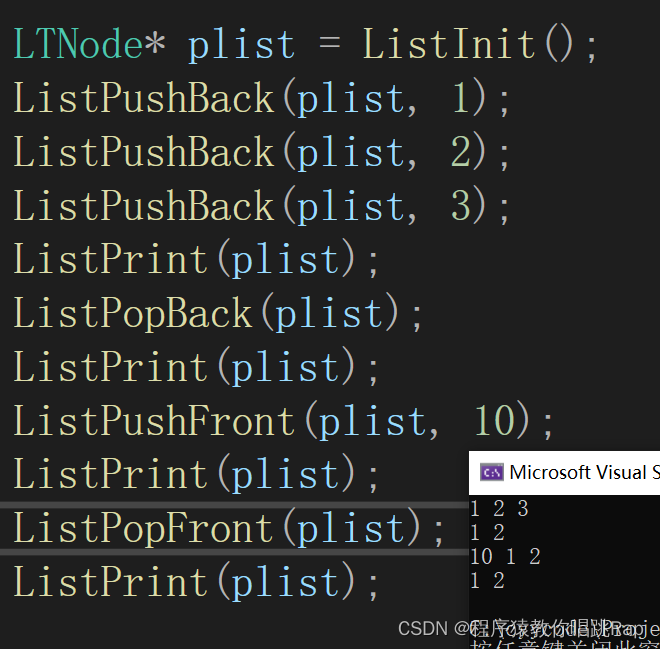
2.8 查找
List.h:
LTNode* ListFind(LTNode* phead, LTDateType x);//查找List.c:
LTNode* ListFind(LTNode* phead, LTDateType x)
{
assert(phead);
LTNode* cur = phead->next;
while (cur != phead)
{
if (cur->data == x)
return cur;
cur = cur->next;
}
return NULL;
}2.9 前插
List.h:
void ListInsert(LTNode* pos, LTDateType x);//前插List.c:
void ListInsert(LTNode* pos, LTDateType x)
{
assert(pos);
LTNode* posPrev = pos->prev;
LTNode* newnode = BuyListNode(x);
posPrev->next = newnode;
newnode->prev = posPrev;
newnode->next = pos;
pos->prev = newnode;
}test.c
#include "List.h"
void TestList1()
{
LTNode* plist = ListInit();
ListPushBack(plist, 1);
ListPushBack(plist, 2);
ListPushBack(plist, 3);
ListPrint(plist);
ListPopBack(plist);
ListPrint(plist);
ListPushFront(plist, 10);
ListPrint(plist);
ListPopFront(plist);
ListPrint(plist);
LTNode* list = ListFind(plist, 2);
ListInsert(plist->next->next, 20);
ListPrint(plist);
}
int main()
{
TestList1();
return 0;
}运行结果:
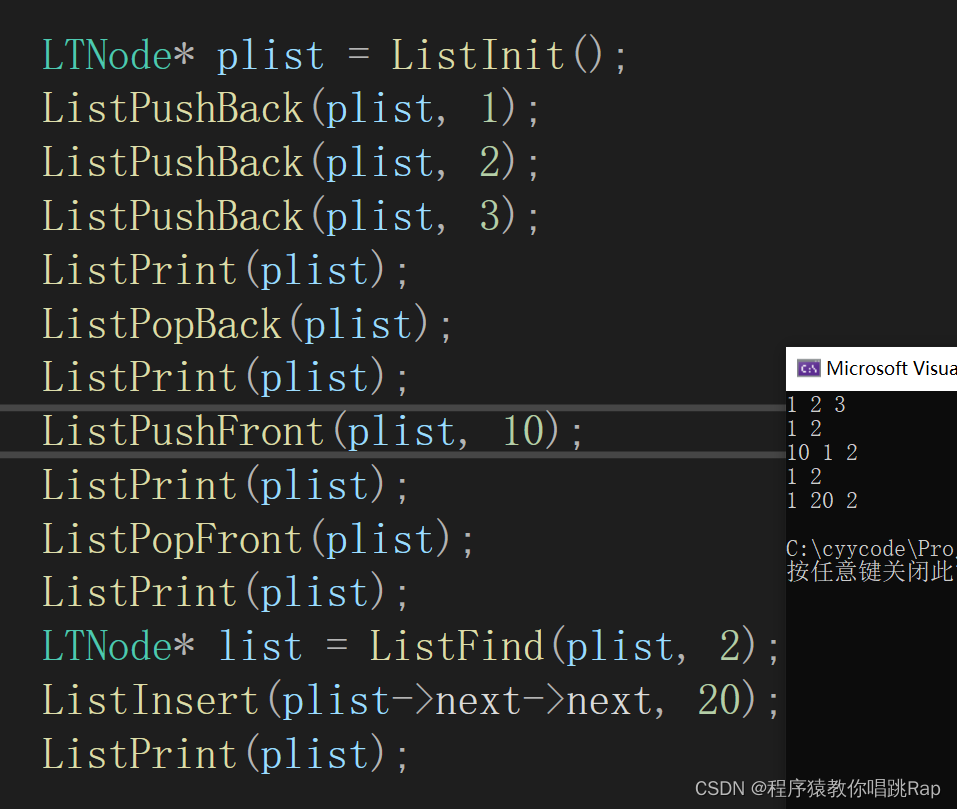
2.10 删除
List.h:
void ListErase(LTNode* pos);//删除List.c:
void ListErase(LTNode* pos)
{
assert(pos);
LTNode* posPrev = pos->prev;
LTNode* posNext = pos->next;
posPrev->next = posNext;
posNext->prev = posPrev;
free(pos);
pos = NULL;
}test.c
#include "List.h"
void TestList1()
{
LTNode* plist = ListInit();
ListPushBack(plist, 1);
ListPushBack(plist, 2);
ListPushBack(plist, 3);
ListPrint(plist);
ListPopBack(plist);
ListPrint(plist);
ListPushFront(plist, 10);
ListPrint(plist);
ListPopFront(plist);
ListPrint(plist);
LTNode* list = ListFind(plist, 2);
ListInsert(plist->next->next, 20);
ListPrint(plist);
ListErase(plist->next->next);
ListPrint(plist);
}
int main()
{
TestList1();
return 0;
}运行结果:
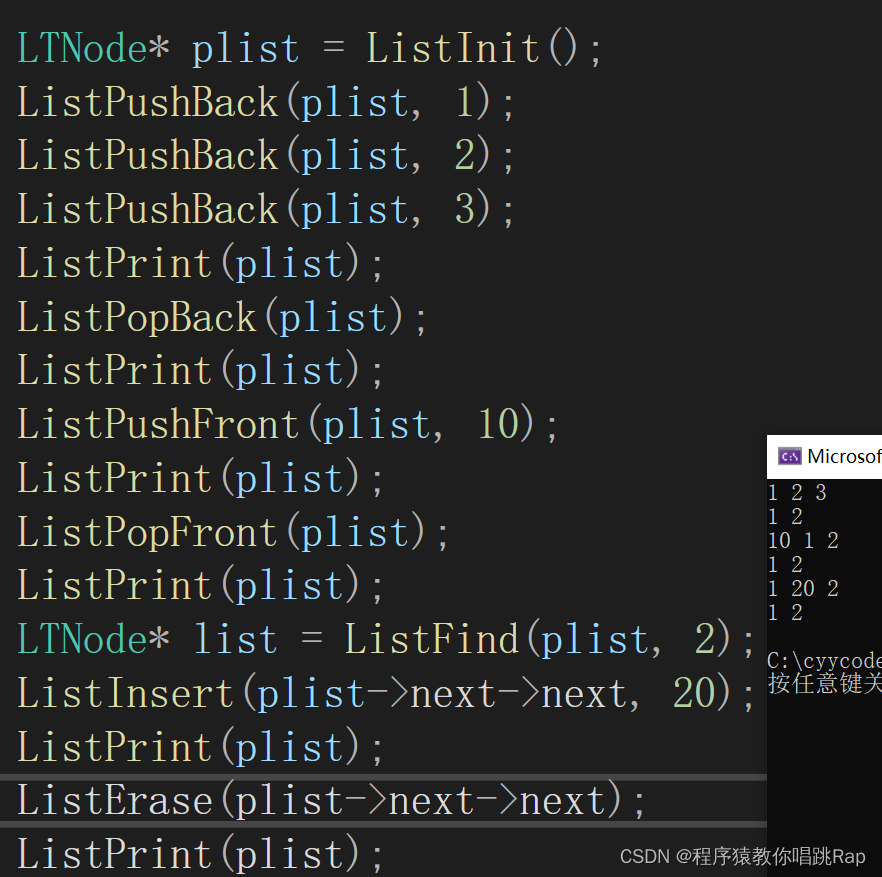
2.11 销毁
List.h:
void ListDestroy(LTNode* phead);//销毁List.c:
void ListDestroy(LTNode* phead)
{
assert(phead);
LTNode* cur = phead->next;
while (cur != phead);
{
LTNode* next = cur->next;
free(cur);
cur = next;
}
free(phead);//置空放在test.c里面,因为形参是实参的临时拷贝
}3.完整代码展示
List.h:
#pragma once
#include <stdio.h>
#include <stdlib.h>
#include <assert.h>
typedef int LTDateType;
typedef struct ListNode
{
LTDateType data;
struct ListNode* next;
struct ListNode* prev;
}LTNode;
LTNode* ListInit();//初始化
void ListPrint(LTNode* phead);//打印
LTNode* BuyListNode(LTDateType x);//申请结点
void ListPushBack(LTNode* phead, LTDateType x);//尾插
void ListPopBack(LTNode* phead);//尾删
void ListPushFront(LTNode* phead, LTDateType x);//头插
void ListPopFront(LTNode* phead);//头删
LTNode* ListFind(LTNode* phead, LTDateType x);//查找
void ListInsert(LTNode* pos, LTDateType x);//前插
void ListErase(LTNode* pos);//删除
void ListDestroy(LTNode* phead);//销毁List.c:
#include "List.h"
LTNode* ListInit()
{
//哨兵位头结点
LTNode* phead = (LTNode*)malloc(sizeof(LTNode));
phead->next = phead;
phead->prev = phead;
return phead;
}
void ListPrint(LTNode* phead)
{
assert(phead);
LTNode* cur = phead->next;
while (cur != phead)
{
printf("%d ", cur->data);
cur = cur->next;
}
printf("\n");
}
LTNode* BuyListNode(LTDateType x)
{
LTNode* newnode = (LTNode*)malloc(sizeof(LTNode));
newnode->data = x;
newnode->next = NULL;
newnode->prev = NULL;
return newnode;
}
void ListPushBack(LTNode* phead, LTDateType x)
{
assert(phead);
LTNode* tail = phead->prev;
LTNode* newnode = BuyListNode(x);
tail->next = newnode;
newnode->prev = tail;
phead->prev = newnode;
newnode->next = phead;
}
void ListPopBack(LTNode* phead)
{
assert(phead);
assert(phead->next != phead);//排除为空的情况
LTNode* tail = phead->prev;
phead->prev = tail->prev;
tail->prev->next = phead;
free(tail);
}
void ListPushFront(LTNode* phead, LTDateType x)
{
assert(phead);
LTNode* newnode = BuyListNode(x);
LTNode* next = phead->next;
phead->next = newnode;
newnode->prev = phead;
newnode->next = next;
next->prev = newnode;
}
void ListPopFront(LTNode* phead)
{
assert(phead);
assert(phead->next != phead);
LTNode* next = phead->next;
LTNode* nextNext = next->next;
phead->next = nextNext;
nextNext->prev = phead;
free(next);
}
LTNode* ListFind(LTNode* phead, LTDateType x)
{
assert(phead);
LTNode* cur = phead->next;
while (cur != phead)
{
if (cur->data == x)
return cur;
cur = cur->next;
}
return NULL;
}
void ListInsert(LTNode* pos, LTDateType x)
{
assert(pos);
LTNode* posPrev = pos->prev;
LTNode* newnode = BuyListNode(x);
posPrev->next = newnode;
newnode->prev = posPrev;
newnode->next = pos;
pos->prev = newnode;
}
void ListErase(LTNode* pos)
{
assert(pos);
LTNode* posPrev = pos->prev;
LTNode* posNext = pos->next;
posPrev->next = posNext;
posNext->prev = posPrev;
free(pos);
pos = NULL;
}
void ListDestroy(LTNode* phead)
{
assert(phead);
LTNode* cur = phead->next;
while (cur != phead);
{
LTNode* next = cur->next;
free(cur);
cur = next;
}
free(phead);//置空放在test.c里面,因为形参是实参的临时拷贝
}test.c
#include "List.h"
void TestList1()
{
LTNode* plist = ListInit();
ListPushBack(plist, 1);
ListPushBack(plist, 2);
ListPushBack(plist, 3);
ListPrint(plist);
ListPopBack(plist);
ListPrint(plist);
ListPushFront(plist, 10);
ListPrint(plist);
ListPopFront(plist);
ListPrint(plist);
LTNode* list = ListFind(plist, 2);
ListInsert(plist->next->next, 20);
ListPrint(plist);
ListErase(plist->next->next);
ListPrint(plist);
}
int main()
{
TestList1();
return 0;
}4.顺序表和链表的区别
不同点 | 顺序表 | 链表 |
存储空间上 | 物理上一定连续 | 逻辑上连续,但物理上不一定连 续 |
随机访问 | 支持O(1) | 不支持:O(N) |
任意位置插入或者删除元 素 | 可能需要搬移元素,效率低O(N) | 只需修改指针指向 |
插入 | 动态顺序表,空间不够时需要扩 容 | 没有容量的概念 |
应用场景 | 元素高效存储+频繁访问 | 任意位置插入和删除频繁 |
缓存利用率 | 高 | 低 |
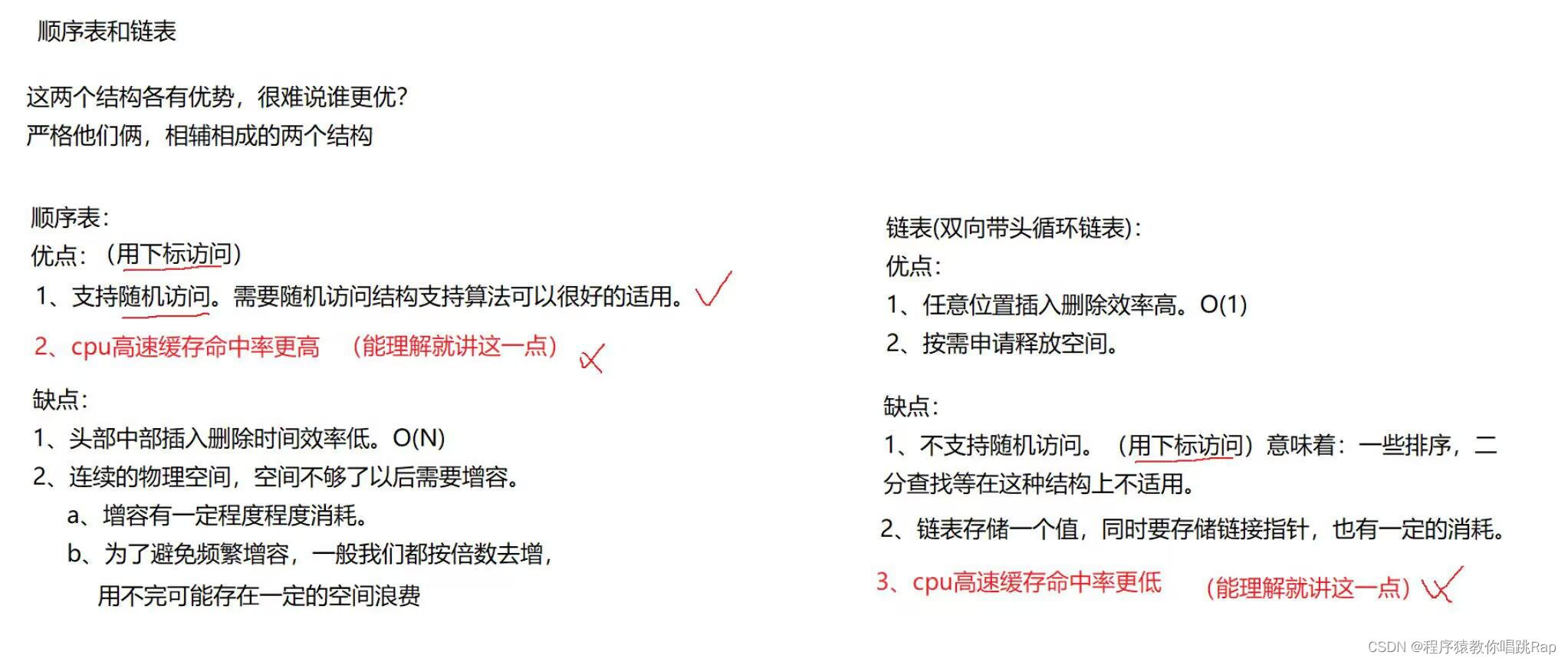
备注:缓存利用率参考存储体系结构以及局部原理性。
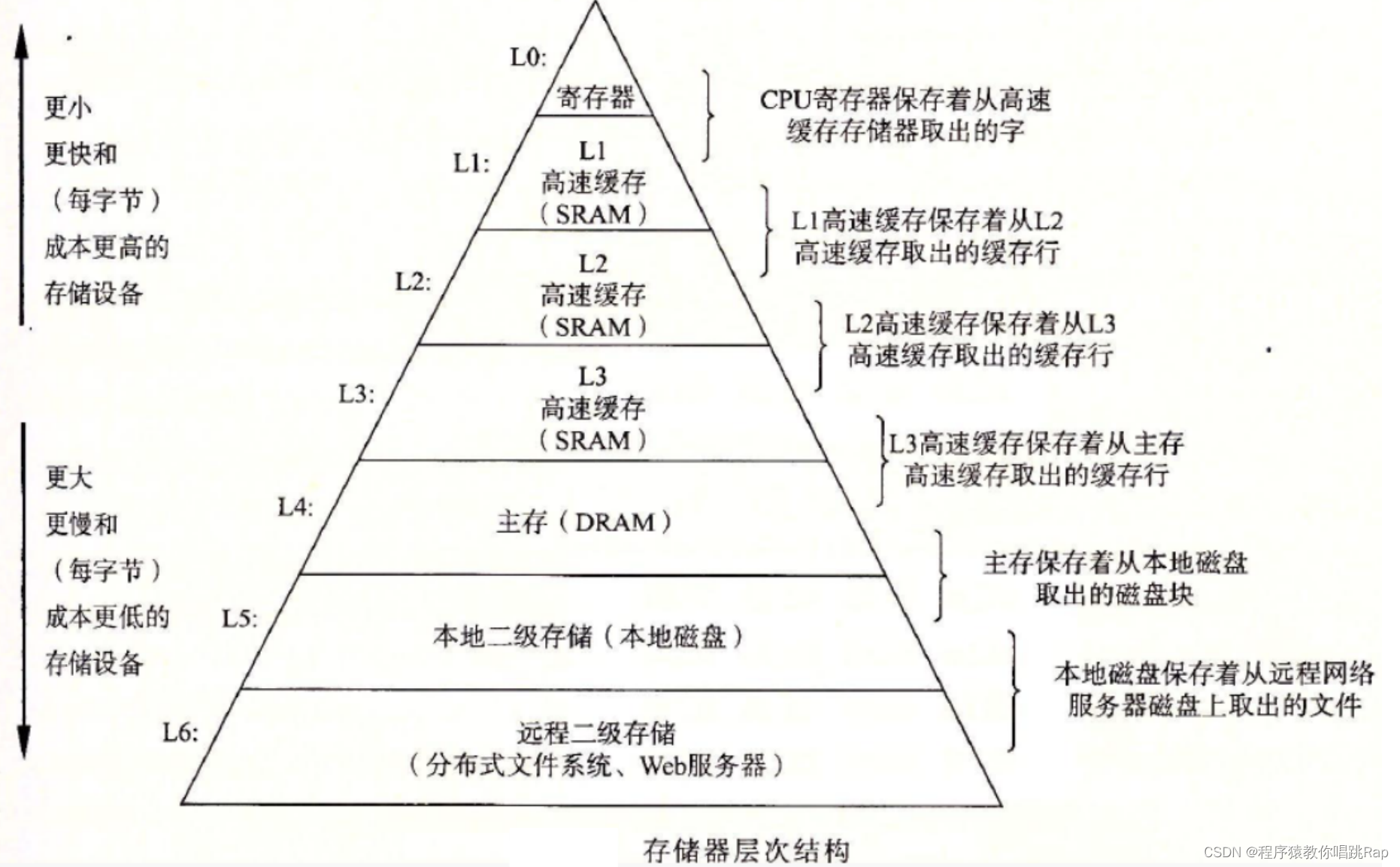
5.链表OJ题
5.1 环形链表(1)
给你一个链表的头节点 head ,判断链表中是否有环。如果链表中有某个节点,可以通过连续跟踪 next 指针再次到达,则链表中存在环。 为了表示给定链表中的环,评测系统内部使用整数 pos 来表示链表尾连接到链表中的位置(索引从 0 开始)。注意:pos 不作为参数进行传递 。仅仅是为了标识链表的实际情况。如果链表中存在环 ,则返回 true 。 否则,返回 false 。
链接:https://leetcode.cn/problems/linked-list-cycle/
bool hasCycle(struct ListNode *head) {
struct ListNode* slow=head,*fast=head;
while(fast&&fast->next)
{
slow=slow->next;
fast=fast->next->next;
if(slow==fast)
{
return true;
}
}
return false;
}
5.2 环形链表(2)
给定一个链表的头节点 head ,返回链表开始入环的第一个节点。 如果链表无环,则返回 null。如果链表中有某个节点,可以通过连续跟踪 next 指针再次到达,则链表中存在环。 为了表示给定链表中的环,评测系统内部使用整数 pos 来表示链表尾连接到链表中的位置(索引从 0 开始)。如果 pos 是 -1,则在该链表中没有环。注意:pos 不作为参数进行传递,仅仅是为了标识链表的实际情况。不允许修改链表。
链接:https://leetcode.cn/problems/linked-list-cycle-ii/description/
struct ListNode *detectCycle(struct ListNode *head) {
struct ListNode* slow=head,*fast=head;
while(fast&&fast->next)
{
slow=slow->next;
fast=fast->next->next;
if(slow==fast)
{
//相遇
struct ListNode* meet=slow;
//公式
while(meet!=head)
{
meet=meet->next;
head=head->next;
}
return meet;
}
}
return NULL;
}
5.3 复杂链表的复制
给你一个长度为 n 的链表,每个节点包含一个额外增加的随机指针 random ,该指针可以指向链表中的任何节点或空节点。
构造这个链表的 深拷贝。 深拷贝应该正好由 n 个 全新 节点组成,其中每个新节点的值都设为其对应的原节点的值。新节点的 next 指针和 random 指针也都应指向复制链表中的新节点,并使原链表和复制链表中的这些指针能够表示相同的链表状态。复制链表中的指针都不应指向原链表中的节点 。
例如,如果原链表中有 X 和 Y 两个节点,其中 X.random --> Y 。那么在复制链表中对应的两个节点 x 和 y ,同样有 x.random --> y 。返回复制链表的头节点。用一个由 n 个节点组成的链表来表示输入/输出中的链表。
每个节点用一个 [val, random_index] 表示:
val:一个表示 Node.val 的整数。
random_index:随机指针指向的节点索引(范围从 0 到 n-1);如果不指向任何节点,则为 null 。
你的代码 只 接受原链表的头节点 head 作为传入参数。
链接:https://leetcode.cn/problems/copy-list-with-random-pointer/description/
struct Node* copyRandomList(struct Node* head) {
//1.拷贝结点插入原结点的后面
struct Node* cur=head;
while(cur)
{
struct Node* copy=(struct Node*)malloc(sizeof(struct Node));
copy->val=cur->val;
//插入copy结点
copy->next=cur->next;
cur->next=copy;
cur=copy->next;
}
//2.根据原结点,处理copy结点的random
cur=head;
while(cur)
{
struct Node* copy=cur->next;
if(cur->random==NULL)
{
copy->random=NULL;
}
else
{
copy->random=cur->random->next;
}
cur=copy->next;
}
struct Node* copyHead=NULL,*copyTail=NULL;
cur=head;
while(cur)
{
struct Node* copy=cur->next;
struct Node* next=copy->next;
if(copyTail==NULL)
{
copyHead=copyTail=copy;
}
else
{
copyTail->next=copy;
copyTail=copy;
}
cur->next=next;
cur=next;
}
return copyHead;
}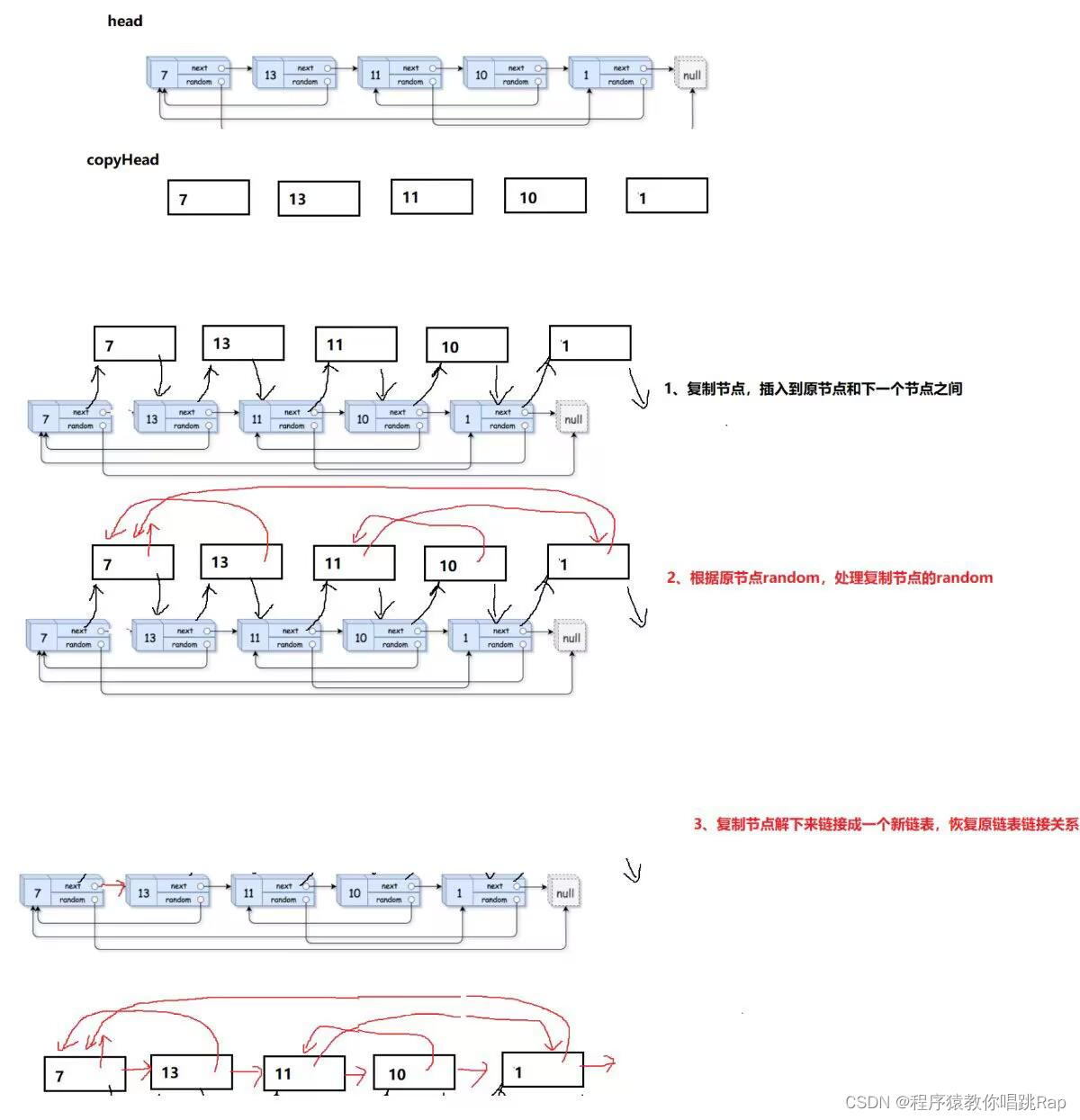
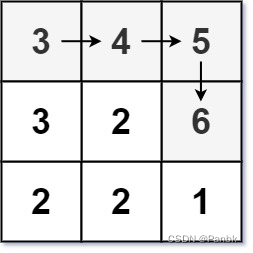


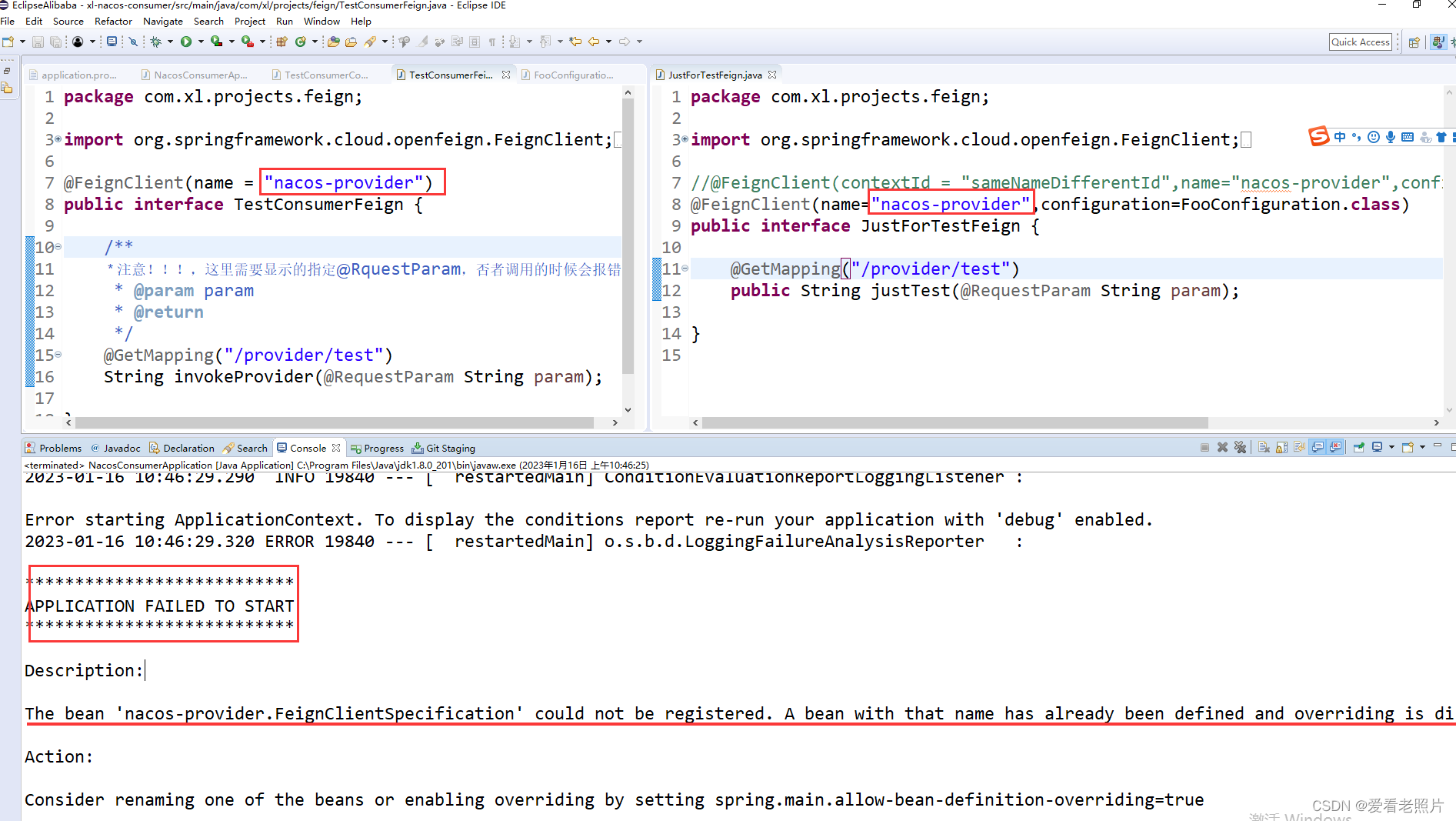
![[拆轮子] PaddleDetection中__shared__、__inject__ 和 from_config 三者分别做了什么](https://img-blog.csdnimg.cn/b9e372fc214c4ff89128210a7661db71.png)
